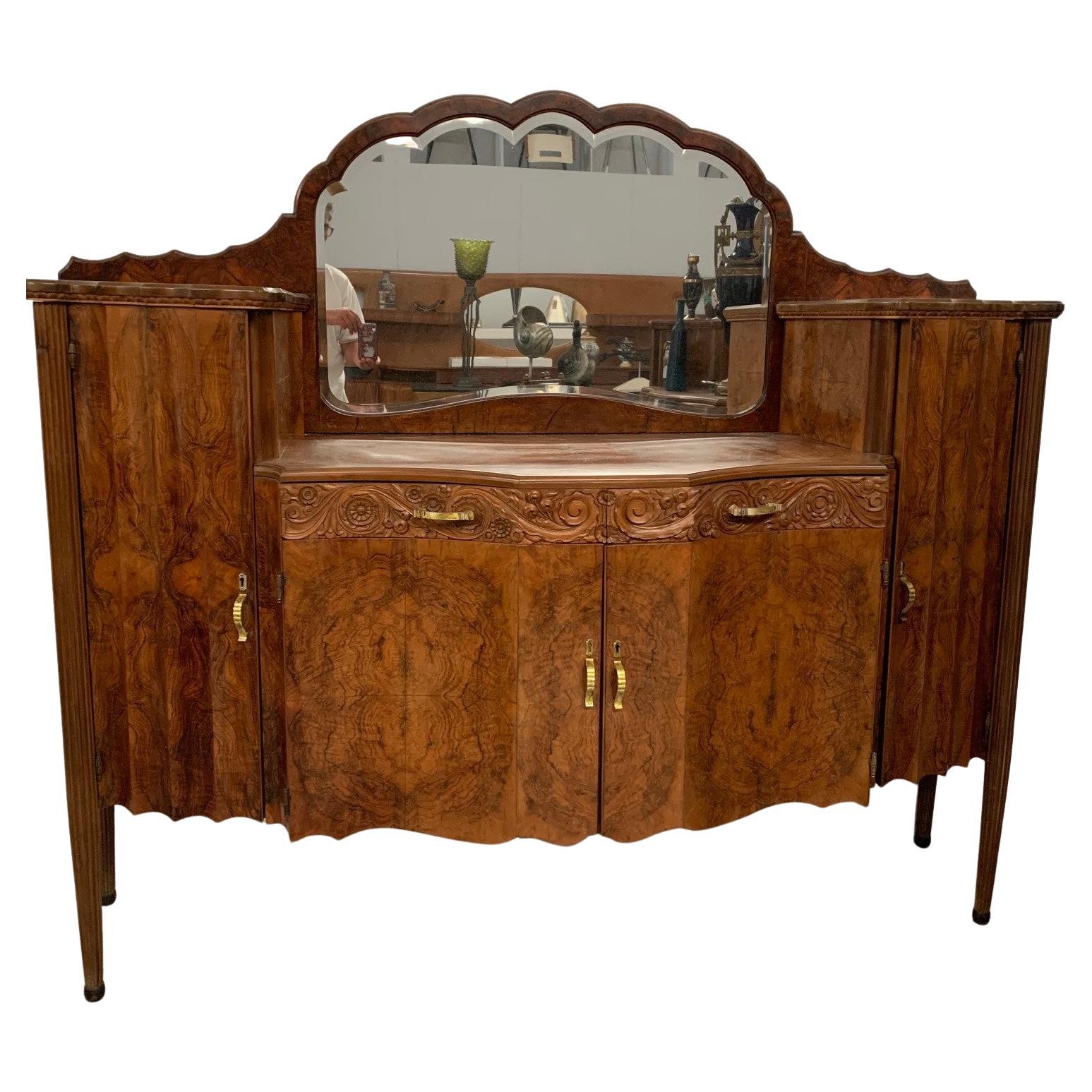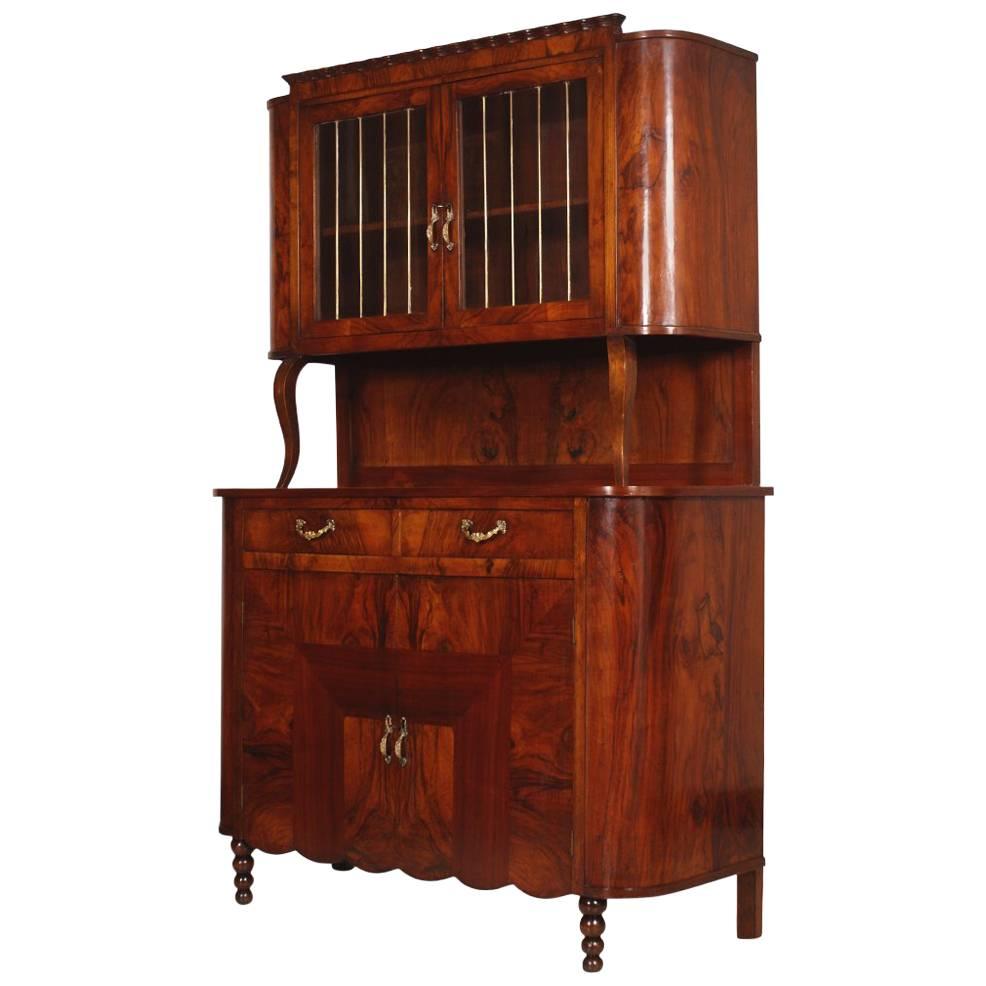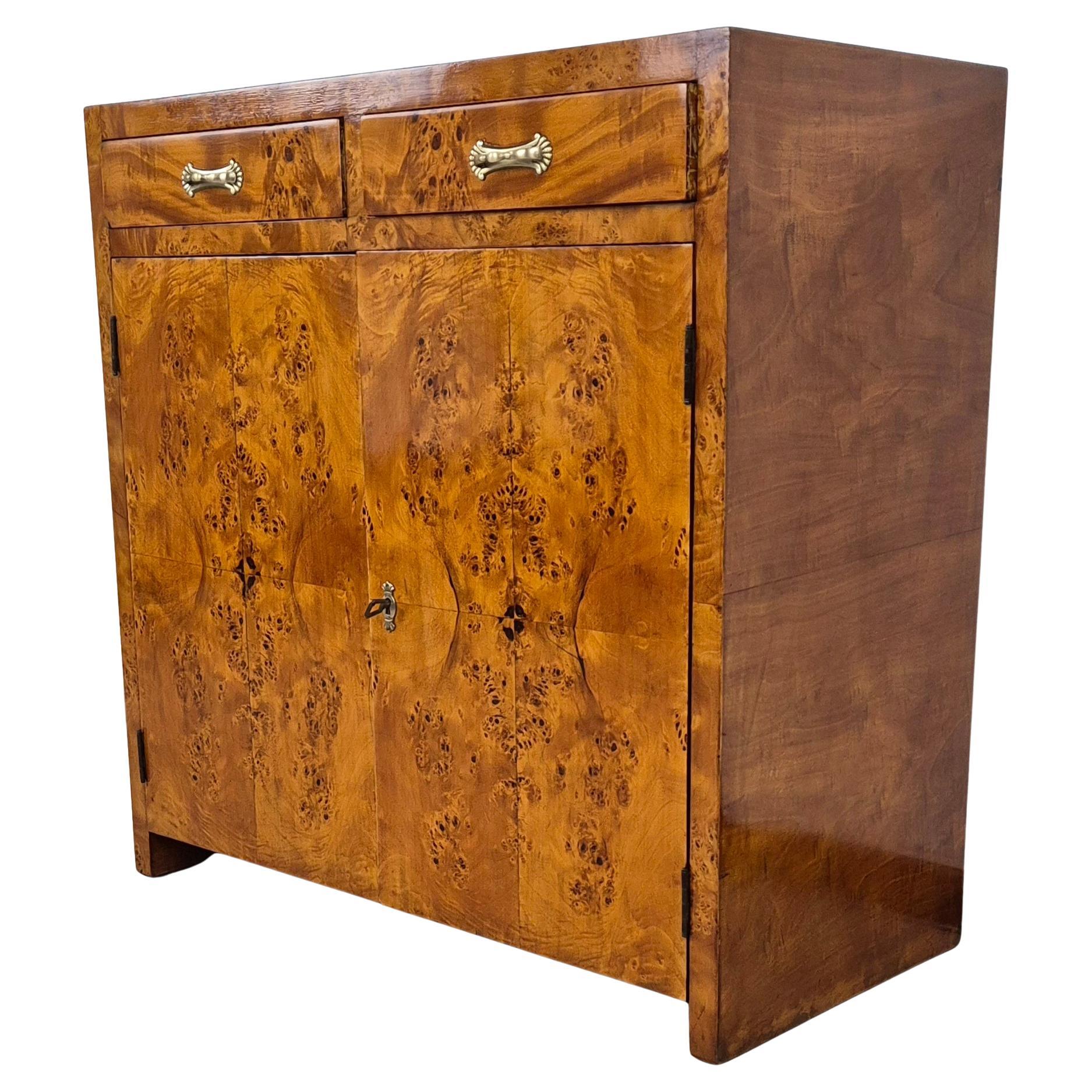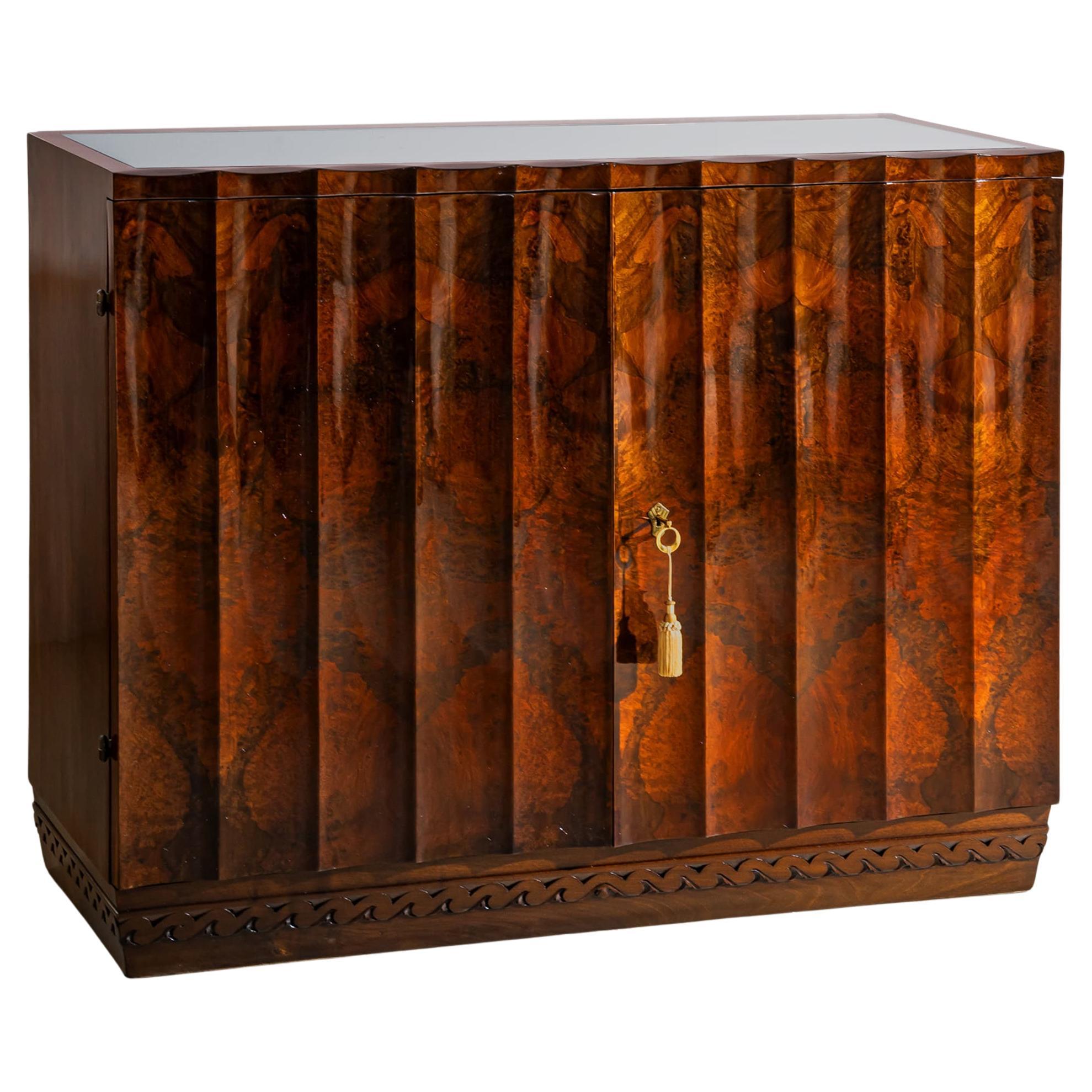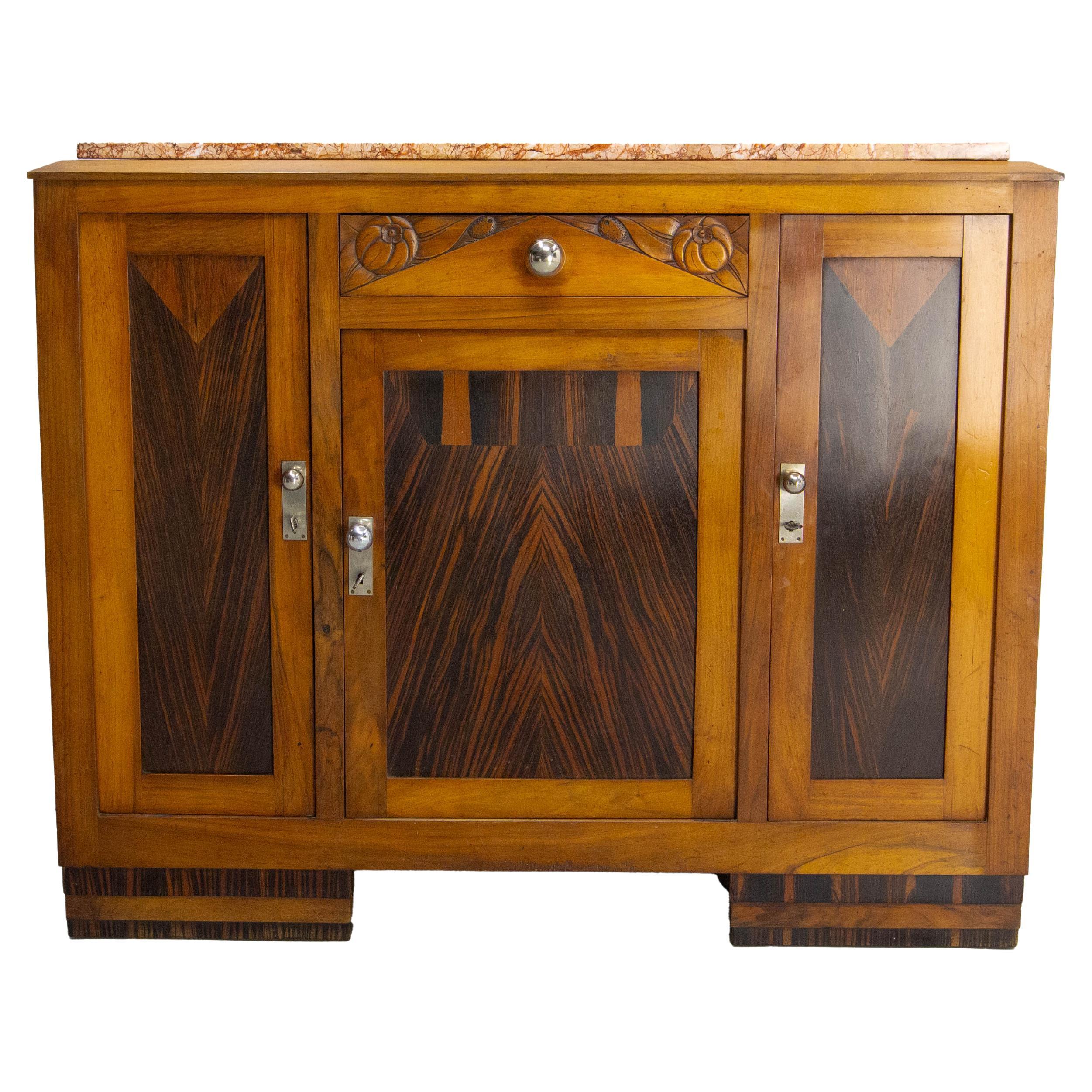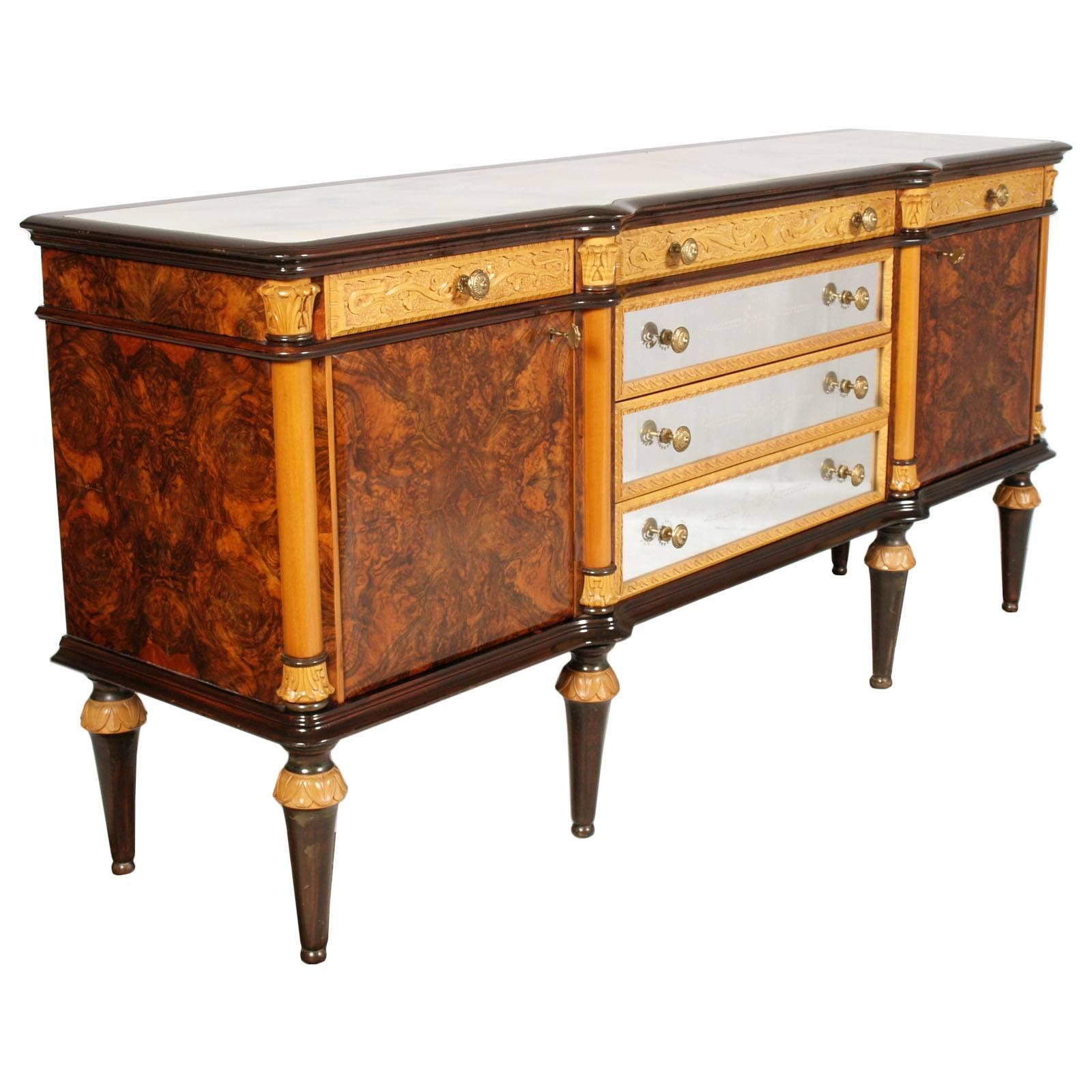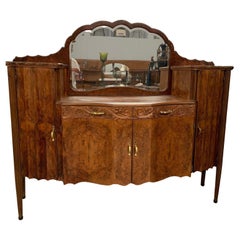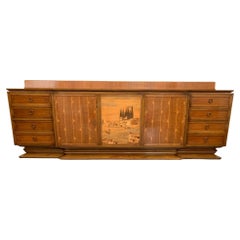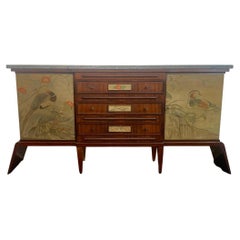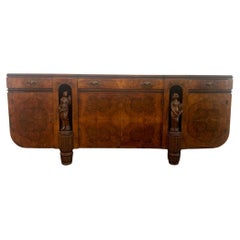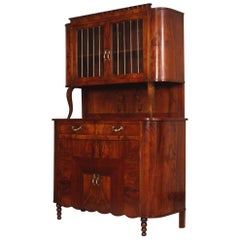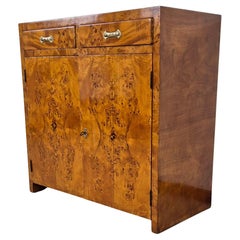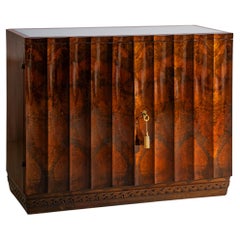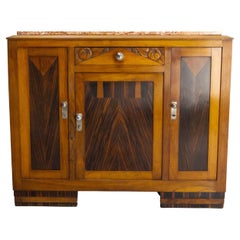Items Similar to Credenza by Dante Morozzi & Marcello Piacentini, 1920s
Want more images or videos?
Request additional images or videos from the seller
1 of 16
Credenza by Dante Morozzi & Marcello Piacentini, 1920s
$5,380.27
£3,983.02
€4,500
CA$7,444.95
A$8,207.89
CHF 4,294.10
MX$100,695.52
NOK 54,054.23
SEK 50,549.25
DKK 34,278.24
About the Item
Sculpture sideboard by Dante Morozzi (Florence 1899 - Geneva 1965), in olive wood and olive briar. The features fully reflect the style in vogue in the fascist period and enclose in the soft and monumental lines, probably the result of his collaboration with "Arch. Marcello Piacentini". On the sides in the niches, the female sculptures, carved in the round are proposed in an elegant and compatible with the furniture, the briar is positioned to mirror the handle and the 4 pendants are in gilded bronze. The signature is present in a similar cupboard present in the salon of origin of the furniture but not available for purchase (see photo). The cabinet has the concept of functional sculpture, the thickness of the sides, the doors and the top are 3cm, it carries weight of 100kg despite the small size. The Florentine sculptor Dante Morozzi, born in the province of Florence in 1899, attended sculpture courses at the Scuola di Santa Croce in Florence, a pupil of Augusto Passaglia, perfecting then Very well known in Cortina d'Ampezzo also for having directed the Institute of 'Art since 1933, he was above all a sculptor, ceramist and painter. In 1933 he participated in the Triennale of Milan organizing the exhibition of the Cantagalli company and from 1933 to 1941 he became director of the State Art School of Cortina d'Ampezzo. From 1935 to 1940 he exhibited at the most important art exhibitions set up in Italy, from the Venice Biennale, to the Rome Quadrennial and again to the Milan Triennale. In 1941 he exhibited at the Il Tevere Gallery in Rome, where he presented a rich choice of sculptures and paintings, and participated in the Cremona Prize. Smart organizer, he is in charge of setting up the South Tyrol exhibition at the VII Triennale in Milan, also presenting three of his sculpted wood works representing the Madonna and Child, Christ and Horse, which unequivocally show his adherence to monumental and heroic ways of the period. Also at the 1940 Triennale, wooden inlays designed by Morozzi were presented by the Art School of Cortina d'Ampezzo, praised by Giò Ponti for their "ease of tone and refinement of colored chiaroscuro" (Giò Ponti in "Domus", June 1940). In 1943 he took part in the Rome Quadrennial. A man with a strong character, for his membership of the fascist party and for his activity as informer, he is repeatedly contested by the Ampezzanis. In 1941 he sold some of his anti-fascist colleagues to the regime, obtaining a professorship at the Brera high school in Milan. At the end of the war he escapes from Italy whose courts sentence him to 18 years of imprisonment for collaboration with the Germans and takes refuge in Geneva where the traces of his life and activities are lost, even his previous activities obscured for the past in service of the fascist regime. He died in Geneva in 1965.
- Creator:Marcello Piacentini (Author)
- Dimensions:Height: 41.74 in (106 cm)Width: 50.4 in (128 cm)Depth: 24.81 in (63 cm)
- Style:Art Deco (In the Style Of)
- Materials and Techniques:
- Place of Origin:
- Period:
- Date of Manufacture:1920-1929
- Condition:Repaired: Slightly retouched and polished. This vintage item is in good condition because it has been completely restored.
- Seller Location:Montelabbate, IT
- Reference Number:Seller: D4621stDibs: LU6481228083702
About the Seller
5.0
Vetted Professional Seller
Every seller passes strict standards for authenticity and reliability
1stDibs seller since 2022
69 sales on 1stDibs
Typical response time: 1 to 2 days
- ShippingRetrieving quote...Shipping from: Montelabbate, Italy
- Return Policy
Authenticity Guarantee
In the unlikely event there’s an issue with an item’s authenticity, contact us within 1 year for a full refund. DetailsMoney-Back Guarantee
If your item is not as described, is damaged in transit, or does not arrive, contact us within 7 days for a full refund. Details24-Hour Cancellation
You have a 24-hour grace period in which to reconsider your purchase, with no questions asked.Vetted Professional Sellers
Our world-class sellers must adhere to strict standards for service and quality, maintaining the integrity of our listings.Price-Match Guarantee
If you find that a seller listed the same item for a lower price elsewhere, we’ll match it.Trusted Global Delivery
Our best-in-class carrier network provides specialized shipping options worldwide, including custom delivery.More From This Seller
View AllArt Deco Sideboard by Meroni & Fossati, 1930s
Located in Montelabbate, PU
Art Deco sideboard by Meroni & Fossati, walnut and walnut briar, Body with a wave-shaped veneered with selection briar veneer and supported by grooved pilasters that end in black lac...
Category
Vintage 1930s Italian Art Deco Credenzas
Materials
Walnut
$2,211 Sale Price
33% Off
Art Deco Style Sideboard by Giuseppe Anzani
By Paolo Buffa
Located in Montelabbate, PU
Sideboard cabinet with drawers and doors, in cherry wood selection, built with disassembly system, three central compartments, base and top. Excellent quality carpentry. The base unit opens to accommodate an order of lines that widen and close until they widen again to accommodate the body of the cabinet. On the sides there are 4 drawers framed with bronze eyelet in the middle, followed by two doors with three-dimensional half stars supported by a maple fillet giving an exquisite combination with the wood grain. In the central room we have the landscape of Punta San Vigilio...
Category
Vintage 1940s Art Deco Sideboards
Materials
Cherry
Art Decò Sideboard in Solid Lacquered & Painted Mahogany
By Vittorio Ducrot
Located in Montelabbate, PU
Gorgeous and unique sideboard in lacquered and finely painted mahogany, the top is made of black speckled white granite. The style is linked to the production of Vittorio Ducrot and Ernesto Basile...
Category
Antique 1830s Italian Art Deco Credenzas
Materials
Granite
$9,564 Sale Price
33% Off
Vintage Sideboard in Walnut Root with Sculptures on the Front, 1920s
By Giovanni Guerrini
Located in Montelabbate, PU
Ebanisteria Casalini Faenza.
Sideboard by Giovanni Guerrini for Ebanisteria Casalini (Faenza), 1930s. Walnut root structure and bronze hardware. On the front are two niches with fema...
Category
Vintage 1920s Italian Art Deco Sideboards
Materials
Bronze
$11,358 Sale Price
47% Off
Sideboard in Rosewood, Breccia and Medicean Stone, 30s
Located in Montelabbate, PU
Wavy sideboards with 3 doors and a central drawer. The feet finely carved in elongated pine cone with ebonized sphere above, are inserted in a niche groove. The tops are in marble br...
Category
Vintage 1930s Italian Art Deco Sideboards
Materials
Breccia Marble
Sideboard in style of Pierluigi Colli for Fratelli Marelli Cantù
By Frama
Located in Montelabbate, PU
Oak and maple burl sideboard, widely popular in the 1950s.
Unique in its kind, with multiple design details and exclusive finishes that complemented each other, making the piece harm...
Category
Vintage 1950s Italian Mid-Century Modern Sideboards
Materials
Bronze
You May Also Like
Early 20th Century Credenza Sideboard Art Nouveau by Meroni & Fossati Lissone
By Meroni & Fossati
Located in Vigonza, Padua
Early 20th century
Credenza vitrine Art Nouveau walnut and burl walnut by Meroni & Fossati Lissone.
Precious and elegant sideboard with original antique patina, wax polished.
A. Mer...
Category
Antique Early 1900s Italian Art Nouveau Credenzas
Materials
Walnut
Milanese Art Deco Sideboard
Located in Mariano Del Friuli, GO
Refined Milanese Art Deco sideboard made entirely of Birch briar with movable Spruce shelf. ( can be placed in 2 positions )
Furniture with special geometries and measurements. ( go ...
Category
Vintage 1940s Italian Art Deco Credenzas
Materials
Brass
Art Deco Sideboard with Wavy Front, attributed to Osvaldo Borsani
Located in New York, NY
Two-door sideboard in walnut featuring a distinctive curved front and a matching wave frieze along the straight plinth base. The dynamic design is echoed in the meticulously bookmatc...
Category
Mid-20th Century Italian Sideboards
Materials
Walnut
Art Deco Credenza Sideboard French Sue et Mare Buffet, circa 1930
Located in Labrit, Landes
Art Deco credenza sideboard French manner of Sue et Mare dresser buffet, circa 1930
Stunning marquetry panels with carved walnut
Floral motifs and mixed woods typical of Sue et Mare
...
Category
Vintage 1930s French Art Deco Sideboards
Materials
Marble
Mid-Century Modern Eclectic Art Deco Credenza by Vittorio Dassi Lissone
By Vittorio Dassi
Located in Vigonza, Padua
A overwhelming beauty eclectic sideboard Vittorio Dassi Lissone attributed.
Styles: neoclassic - with renaissance engravings and art nouveau-mi...
Category
Mid-20th Century Italian Art Deco Credenzas
Materials
Onyx, Bronze
Mid-20th Century Italian Art Deco Sideboard, Italy
Located in New York, NY
This impressive Italian Art Deco sideboard from the 1940s features six doors and a central section distinguished by a wavy front, accented in satinwood. The remainder of the sideboar...
Category
Mid-20th Century Italian Sideboards
Materials
Satinwood, Walnut
More Ways To Browse
Horse Mirror
Bronze Man Art Deco Sculptures
Horse Inlay
Life Size Sculpture Of Man Bronze
Antique Cantagalli
German Art Deco Sideboard
German Deco Sideboard
Gio Ponti Horse
Marcello Piacentini
Heals London
Designer Sideboard
1930s Vintage Sideboard
Inlaid Sideboard Italian
Kofod Larsen Rosewood
Low Mid Century Cabinet Teak
Upcycled Furniture
Mid Century Sideboard Maple
Green Lacquered Sideboard
